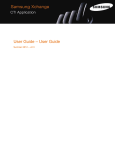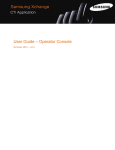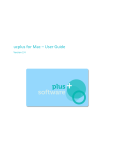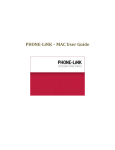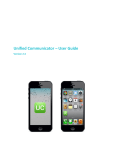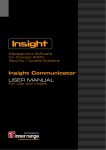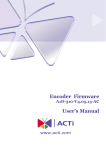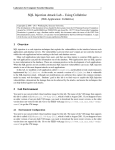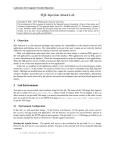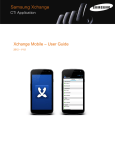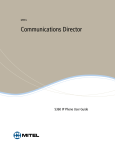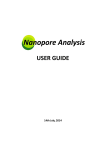Download ucplus – User Guide
Transcript
ucplus – User Guide Version 2.4 Contents Welcome to ucplus .................................................................................................................................. 3 Where is it? ......................................................................................................................................... 3 Tray menu ............................................................................................................................................... 3 Phone window ........................................................................................................................................ 4 Preview window ...................................................................................................................................... 4 What would you like to do? ................................................................................................................. 5 Making calls ............................................................................................................................................ 6 Call Control............................................................................................................................................ 10 More call control ............................................................................................................................... 11 Address books and contacts .................................................................................................................. 12 Storing contact details when on a call ................................................................................................ 13 Adding contact details from the Call History window ......................................................................... 13 Call History ............................................................................................................................................ 13 Presence ............................................................................................................................................... 14 Messaging ............................................................................................................................................. 15 Select Peer ........................................................................................................................................ 16 Message History ................................................................................................................................ 16 Settings and configuration ..................................................................................................................... 17 Telephony ......................................................................................................................................... 17 Interface settings ............................................................................................................................... 18 Dialling settings ................................................................................................................................. 19 Events settings .................................................................................................................................. 20 Integration settings ........................................................................................................................... 21 Versions & Log settings ...................................................................................................................... 22 _____________________________________________________________________________________ ucplus – http://plus-software.com/ Page 2 Welcome to ucplus ucplus has been designed to make your phone easier and more convenient to use. It can do this in a number of ways and this document will show you how. Where is it? ucplus is designed to be discrete. Always running and providing useful information as you need it, yet at the same time not annoying and interfering when you’re trying to work. So, most of the time, ucplus sits silently in your tray menu, waiting for you to click on it. Note: In Windows 7, some tray icons become hidden and expressly have to be shown. These settings are stored in the ‘Notification Area Icons’ part of the Windows Control Panel. So go ahead and right-click on the ucplus icon, which is a green circle (or red if you’re on a call) and the tray menu should appear. Tray menu Quick dial box: Type the number to dial or enter the name to find contact details. Recent menu: Quickly see recently dialed numbers, and click to redial them. Features: Setup DND and Call Forwarding on your extension. Availability menu: Change your status as it appears to other users of the software. Can be automatically set if Outlook integration is enabled. Configuration: Contains options to change your user experience, and configure CRM packages to integrate with. Exit: Use this to unload the software. _____________________________________________________________________________________ ucplus – http://plus-software.com/ Page 3 Phone window The most obvious place to start is the Phone window (pictured below). Click on that option in the tray menu, or in future you can simply double click on the tray icon and the window will be shown. Let’s have a look at the main parts of the Phone window: Main menu: Click here to display the main menu. Contact information: The name and telephone number of the remote person. Actions: Use these buttons to interact with the current call and contact. Notes: Display information stored in the contact’s notes (Shared Address Book only). Call information: Other information about the current call. At the start, you’re likely to use the Phone window if you want to control calls or show contacts. After you’ve used the software for a while, though, you’ll probably prefer to use the Preview window it can be more convenient and less intrusive. Preview window Make a call in to your extension again and the Preview window should appear. It contains much of the information from the main Phone window, but in a much more compact format. Plus it will disappear shortly after a call connects. Let’s review the main parts of the window: Close button: Use this to make the Preview window disappear more immediately. Contact information: The telephone number and name of the other party. Call control actions: Use these to interact with the call. Using some of these will display the main Phone window. Like the Phone window, the actions at the bottom of the preview window adapt to the state of the call. The example picture shows the actions that are available when a connected call is in progress. To conserve space, the text is only shown for the first action. The rest are depicted by their icons only. _____________________________________________________________________________________ ucplus – http://plus-software.com/ Page 4 What would you like to do? Are you still with us? Congratulations. Many people just go straight to the software and figure it out from there. But you know what? They’re missing out. This is where we show you how to get the most from the software. Plus, it’s presented in a topic-by-topic way, so you can read the sections that you’re interested in first. So what would you like to know? Have a look at the choices below. They are presented in a logical order based on the tray menu. They are not necessarily in order with the most interesting first, so feel free to skip over any that look dull: Making calls Call Control Address books and contacts Call History Presence window Messaging Settings and configuration How many different ways can you make calls? Which are the best? How can you control calls from your PC? What is the best way to work? How to assign names to callers and how best to use this information. Taking a look at your call history and what you can do with it. Publishing your availability and seeing if other people are free Chatting via the built-in instant messaging client and reviewing previous conversations. How do you configure ucplus to get the most out of it? Want to know how to assign names to callers? Read Address books and contacts. Want to know how to control calls? Read Call control. _____________________________________________________________________________________ ucplus – http://plus-software.com/ Page 5 Making calls So, we’re going to look at ways of making it easier to call people. But at the same time, we don’t just want to use technology for the sake of it. So where do we start? Well, the best way to do this is to look at the different ways that you might get the number that you’re going to call, and then look at the best way to call them. For instance, you might be browsing the internet and see the telephone number of a company who you’d like to call. In this instance, the most natural thing would be to click on the number to dial them. We call that internet dialling (more about this later). Or if you are using your company’s Contacts Management program and you have a contact’s details on screen, you don’t want to have to lift your handset and dial the number by hand. There’s a much easier way now. So when you make calls, where do you get the numbers from? Let’s look at some possibilities: From a piece of paper Well, you might as well lift your handset and dial the number on your telephone keypad. But if that’s the case then you should think about storing the person’s name in ucplus and then next time, you can find them more easily. Alternatively, you could right click on the ucplus tray icon and then enter the number in the text box at the top. You can even use the backspace key if you type it wrong. Easy, eh? Or, if you happen to have the Phone window open, then just start typing a number on your keyboard. ucplus will understand that you want to make a call and switch to the “Make call” screen. Press the Enter key when you’ve finished typing to make the call. Someone you spoke to If you spoke to them recently using the phone that ucplus is connected to then the call should be in your call history. At the main menu, press the call history button and you will get a list of your calls in reverse date order. If you see the caller in this list, then click on their telephone number to make a _____________________________________________________________________________________ ucplus – http://plus-software.com/ Page 6 call to them directly from this screen. Alternatively, if the person was one of the last ten people that you spoke to, then they will be in your “Recent” list. You can get to the Recent list from either the ucplus tray icon or from the Make call screen. Note: these Recent numbers are stored on your PC not on the server. From a web page You can configure ucplus to search your web pages (for supported browsers) for telephone numbers to dial. It won’t find all of them, unfortunately, but it is good at phone directory searches because it is optimized to understand this kind of page. To turn this functionality on, you need to go to the Configuration main menu option and then go into Dialling settings. Here you can turn on “Web Page Dialling”. Some web pages, such as Contact Management systems may contain text boxes with telephone numbers in. These work slightly differently because we can’t make these into hyperlinks. To add dialling support to this type of web page, then you will need to tell ucplus to search for them. This is also done from the Configuration screen. To add dialling support for the application, you need to follow a couple of simple steps: i) ii) iii) iv) From another application In the Configuration screen, on the Dialling page, press the Add button. This will load the Dialling wizard. Select the Internet Explorer option, then choose Text boxes. Locate a page in your application that contains telephone numbers in a text box. Enter the telephone number that is shown in your application into the wizard. Then press the Detect button. ucplus will then scan all open web pages and find the first instance of your number (you can only do one at a time). Press the Save button and in future (next time you refresh the page) it will add a Dial button next to the text box. It is very common to store telephone numbers on a PC, particularly in contact management applications. However, applications actually vary a lot as to how these numbers are presented. This gives quite a challenge for applications such as ucplus to make dialling possible. Fortunately, we’ve been doing this kind of thing for a while and we’ve put some nice tools into ucplus to allow you to dial from other applications. The first and easiest of all of them is Clipboard dialling. Clipboard dialling can be turned on in the Settings -> Dialling settings page. When on, ucplus will keep an eye _____________________________________________________________________________________ ucplus – http://plus-software.com/ Page 7 on the clipboard and if you copy something to it that looks like a telephone number then a bubble will appear from the tray icon that asks you if you want to call the number. When using this method of dialling, you may want to help ucplus know what is a valid number by entering a minimum and maximum length and possibly a prefix that numbers must start with. This can be done in the Dialling settings page. If you regularly dial from a certain application then there may be a quicker way to dial. This involves a detection phase where ucplus learns your application, and is called Application dialling. To try it out, go to the Dialling page in the Configuration. At this screen then press the Add button and you can try to detect your application. The way that you do this is as follows: i) Select the “Any other type of Windows application” option, then press Next. ii) On the next page, click and hold the mouse down on the crosshair next to the word “Detect” as in the screenshot above. iii) Drag the mouse (without releasing the button) over the text box in your application when a number is stored. iv) Release the mouse button when the mouse cursor is above the textbox. (This obviously means that you need to get ucplus and your application side-by-side to achieve this). If the crosshair icon changes to a check then it is likely that ucplus can add dialling support to this box. v) When you have finished then press the Next button and then press the Close button to save the settings. Then press Save in the main configuration page too. Next, close and reopen your application window to see if it has worked. The results will depend on what type of application it is. You will either see one of three possibilities: _____________________________________________________________________________________ ucplus – http://plus-software.com/ Page 8 From your own inhouse developed application or database. i) A dial button will appear to the right hand side of the text box. This means that you have a “.Net application”. (You probably saw a check when doing the detection also). If this is the case, then you should proceed to “Detect” the other text boxes in your application to make them work also. ii) Alternatively, try hovering your mouse above the text box (making sure that there is a valid telephone number in it). All being well, a Dial and Hangup button will appear to the right hand side of the text box. This means that you have a non-.Net application. iii) If neither of these two things happen, then the text box probably isn’t supported, so you should consider using the Clipboard method instead. Note: you might also be trying it with an webbased application, if so then have a look at the earlier section under dialling from a web page. We have to get a little “techie” here, so if you don’t develop your own inhouse applications, then feel free to skip straight past this. So what kind of an application do you have? i) Web-based: If so, then we suggest that you put “Anchors” <A> around any telephone numbers. The href should be “Dial: 123” and replace 123 with your real number. If you want to put Dial buttons next to your input textboxes or under buttons, then we suggest that you use the window.OpenURL function and construct a string containing “dial: 123” as a parameter (changing the number to the correct one obviously). ii) Non-web based: When you want to make an outbound phone call (ie by putting a Dial button next to a text box) then do so by running or shelling the PhoneHelper.exe program (found in the same directory as ucplus) with a command line parameter of “Dial(123)” (without the quotes). So, that’s it for dialling options. Unless you can think of any more… _____________________________________________________________________________________ ucplus – http://plus-software.com/ Page 9 Call Control By now, you will probably have seen the Call screen in the Phone window a number of times. It appears when you make or receive a call. Let’s take a moment to review the items on the screen. Main menu: Click here to view the main menu. Contact information: The name and telephone number of the remote person. Page left/right: Use these to switch between calls when you have more than one call in progress. Call actions: Use these buttons to interact with the current call. Call information: Other information about the current call. As you can see, the Phone window allows you to interact with the current call in a number of ways. One of the most common ways is to click on the “New contact” or “Show contact” button to add a new name or to view the current caller’s details. This is covered in a later section, Address books. It is also common to use this screen to perform a transfer of the current call to another extension or user. To do this you must be connected to the call (as opposed to it being on Hold or Ringing). When you are connected then the Actions list looks like the above example. To transfer a call you do NOT press the Hold button. The Hold button has a different purpose (more about his later). Instead you either press the Consult or Transfer button. You choose the button according to whether you want to speak to the other person (Consult) or not (Transfer). You are then presented with a screen like the Make call screen, but with the word Consult or Transfer at the top. Your call is not on hold at this stage yet, but when you are ready, type the number to transfer to (or choose one of the dialling options) and if you are Consulting then the original call will be put on Hold pending transfer (the pending transfer bit is important). If you are transferring then the call will be put straight through (remember to say goodbye first). When you have finished talking to your colleague, you can either click Cancel to return to the original call or click Complete to transfer the original call to your colleague. You can also transfer calls by using the Presence window. This feature is covered later in that section. _____________________________________________________________________________________ ucplus – http://plus-software.com/ Page 10 More call control We’ve seen what you can do with a connected call. Can you interact with other calls? Yes, when a call is ringing, you can choose to answer the call or Deflect it (transfer it without answering it) to another extension. Deflecting a call is done in a manner similar to transferring calls. If you want to use this feature, then why not go ahead and try it out now. Phone in from your mobile and see how it works and then you’ll be ready if you need to deflect a call for real. Deflecting calls is not just used to avoid work. If you are already on the phone and someone else phones you, then you can use Deflect productively to move the call to a colleague who can tell the caller to wait for you to become available. You can also put calls on hold. Depending on your telephone system configuration, this means that the other person should hear music. When you are ready to talk to them again, use the Unhold button. Remember, the Hold button is not for transferring calls. It is purely to pause the call. If you want to transfer a call that is on hold, then first you will have to take the call off hold first. ucplus allows you to pick up a call ringing on another extension. This feature is especially useful if you know that one of your colleagues is unable to answer the call or is not at his desk. You don’t have to get up from your desk anymore to pick up the call, just go to the Presence Window right click on the ringing extension and “pick up” the call. You can use Send Digits to enter further digits during a phone call, when using an automated phone system for example. Clicking the Send Digits button changes the Actions panel to an alternate view of a numeric keypad like on a conventional phone. Click the numbers as you need them and click the Actions button to switch back. _____________________________________________________________________________________ ucplus – http://plus-software.com/ Page 11 Address books and contacts The Address book window is accessed from the Address book item on the main menu or tray menu icon. It provides access to a company-shared address book. Unless you’re the first person to use the software at your company, then there are probably some entries already in there. Go ahead and have a look. Don’t worry about filling in any of the boxes, just press the Search button at the top and see if there are any entries already there. If you see an entry click on the contact name, it should display the contact details including the call history. If there is no contact, we’ll add one now. At the top of the window, press the New Contact button. This will present you with a blank Contact window. Enter a name, company and phone number in the relevant boxes. All of the boxes from the Contact window, including the Notes box at the bottom, can be searched. You can also interact with some of the boxes to make a call, send an email, etc. You may be wondering what the “Type” box is for at the top of the page. This is used to change the format of the Contact window. Different “types” have different templates. Pick the one that best represents the contact entry that you are creating. When you’re finished press the Save button and we’ll search for your new entry. Back at the main Address book window, enter search criteria to find your entry. Most of the time, you can find the results that you want by entering text in the search box and pressing Go. However, if you get too many results back, you may want to consider further restricting your search by using the Advanced section. Names and telephone numbers area searched using the original Search box, but in the Advanced section you can filter by address fields such as town or postal code (Where) other fields (What) and the specific database where you think the contact might be currently stored (Source). Press the Search button and after a short delay you’ll be presented with a list of results. From this screen you can click on the telephone number of a contact to dial them, or click on their name to edit or view their contact details. _____________________________________________________________________________________ ucplus – http://plus-software.com/ Page 12 Storing contact details when on a call If you’ve made or received an external call using the Phone window yet, you’ve probably noticed that when ucplus doesn’t know who the other party is that you’re speaking to, then it will show a town or location name instead. It does this in an effort to be helpful, but if you really want to help yourself, then you’ll add a name to the contact for future use. How do you do this? You press the “New contact” button on the right hand side of the screen. (You already knew this, didn’t you?) You can then store the caller’s details for future use. Adding contact details from the Call History window You may find it easier to add a contact’s name and other details after the call has ended. This is fine, you can concentrate better this way. To do this, go into your Call History and click on where the name would appear (it will be a location name in brackets instead). When you do this, the Create contact window will appear like before. It’s a good idea to have a look in your Call History, from time to time, and enter caller’s details in this way. That way, when you’re looking for someone’s number, you will be able to find it. Call History Once you’ve used ucplus for a while you will come to rely on the Call History. It’s a great way to find the telephone number of someone who you spoke to recently. The Call History window is accessed from the Call History item on the Main menu or from the tray icon menu. As well as reviewing recent activity you can dial someone from here by clicking on their telephone number and you can access their contact record here by clicking on their name (we saw this in the Address Book section). It’s good practice to store the names of people when you speak to them, especially if you’re likely to speak to them again. By default, the Call History screen returns the fifty most recent calls. The next fifty can be accessed by pressing the page right button in the bottom right of the window. Call history can be filtered using the _____________________________________________________________________________________ ucplus – http://plus-software.com/ Page 13 criteria: “Direction” (Inbound or outbound), “Answered” (Answered or Not answered), “External calls” (External or Internal), Time and Duration of the call. Also, to aid readability you can hide and show individual days from your history by pressing the expand/collapse button to the left of the date. Presence In its most basic form, the Presence window provides a quick way to check the availability of your colleagues. The Presence window is accessible from the tray menu. When you first install ucplus, then the Presence window should contain a list of all the extensions, unless your administrator has chosen a different arrangement. If you right click on one of the entries in the Presence list, then a context menu should appear. Assuming that you are not already on a call, then the menu should contain the Make call item. By choosing this action, you can dial the extension directly. If you had been on a call already, then the choices would have been Consult and Transfer in place of Make call. This is appropriate because, if you are already on a call, then the expectation is that you are clicking on the extension with a view to transferring the call to them. What other actions can you perform? Well, if you see an extension that is flashing red then it means that the extension has a call ringing at it (you might be able to hear the phone if it’s nearby). Click on the extension and the context menu will include an option to Pickup the ringing call. The other colours that you might see are on the Presence list are solid red, which means that the extension is engaged on a call, and fluttering yellow, which means that there is an held call at the extension; solid grey means the extension is offline. If you want to personalize your Presence window to include just the contacts that you need, then you can do this in the Presence settings page under the Settings menu (in the Phone window). The other styles that you can choose, instead of extensions, are Users or custom. The user list is for hotdesk oriented sites. These are sites where staff moves around and hence the list is oriented toward who is available and where they are, rather than which extension is available. In user mode, the Users are shown as coloured “chess pawns” instead. The “Users” view will also update the “State” field of the user based on the status of any devices that the user has logged in with (for example; PC client, mobile client), so the user will show as red if they are either busy on the deskphone or mobile phone. _____________________________________________________________________________________ ucplus – http://plus-software.com/ Page 14 Clicking the Send Message option on the context menu will open the integrated chat window. Then you can send instant messages directly to that user or extension. Full information on messaging can be found in the Messaging chapter. You can also right-click on an extension and select the Call History option to see their Call History. You need to have a security policy with sufficient rights to do so but you can use their Call History as easily as your own with all the functionality intact. The Presence window also allows you to see your colleagues ucplus Mobile current location (“Location Update Frequency” must be turned on the Mobile client). Your colleagues location will be reported as a text description of their geographical location back to the ucplus server (ucplus server requires internet access for this feature). The geo-location of colleagues mobile device is made visible to you via the location field in the Presence screen or by clicking on “Show on map” option which will open the web browser to show the user’s approximate location in Google maps. Messaging Sometimes, calling a colleague isn’t an option but you really need to get in touch with them, perhaps they are on an important call so you don’t want to interrupt but have important relevant information. That’s where Messaging steps in to help out. You can use the integrated chat window to communicate with them without tying up their line or having to interrupt a connected call. To start a conversation, open the Presence window, then right-click on the extension or user you want to send a message to and click the Send Message option on the pop up context menu. Conversation: All of the previous messages in the conversation are displayed here in chronological order. Just click on any hyperlinks to follow them. To box: Names/numbers of the message recipients are typed here or you can use the button at the end of the box to add them (see Select Peer). Multiple recipients should be separated with semicolons (;). Rich text: Select the input text to modify then select an option from this pop up menu to apply an effect or select an option and then type. Text input: Type your text here and press Enter to send your message. Hyperlinks can be typed or pasted and are formatted automatically _____________________________________________________________________________________ ucplus – http://plus-software.com/ Page 15 Select Peer If you click the button at the end of the To box to add recipients, you’ll see the Select Peer screen. It lists the different users, extensions and supported devices connected to the telephony system. Type: Select which type of peer to display from All, Extension, All devices or User. Search button: If you change the search text, click the Search button to update the list. Search text: Enter the text to filter the search results by. To show every peer of the selected type just leave this box blank. Peer results: The peers that have been found are displayed here. Select the peer to add and click OK; multiple peers can be added simultaneously by holding down the Control key and clicking each peer in turn, then clicking OK. When you have added a recipient, if their name or number appears in the To box with a line under it, the chat window has recognized it and your messages will be sent to this user or extension. If a name/number has a line through it, the chat window cannot deliver messages to it. Message History When you need to refer back to conversations you’ve had in the past, you can view the Message History. It’s similar to the Call History except you can go back to the conversation and read every word. New message: Click here to open a new chat window; you’ll need to add all recipients manually though. Delete message: Click on the message to delete, then click this button. This cannot be undone so use with caution. Search text: Enter the text to search for within the messages. Leave this blank to show every message. List display options: Use the options in this menu to control what is displayed and how. Search button: Click this to update the message list below when you change the search text. Conversations: Click on a conversation to display it in a new chat window. You can continue a conversation once it’s been reopened. Page: Use the arrow buttons or type the page number you want to view into the box. _____________________________________________________________________________________ ucplus – http://plus-software.com/ Page 16 Settings and configuration The Settings menu contains many options that you can change to improve your enjoyment of ucplus. Let’s take a look at some of the more common ones. If you select the Configuration menu item from the tray menu then you are given a page with an options on the left hand side. Telephony When you first install ucplus, it takes you through an installation phase where you need to tell it your telephony server’s address and your extension number. When it does this, it presents the Telephony settings page of the Configuration window, so you may have seen these before. You’re not that likely to change these settings, but you might as well know what they do. The first option, Server, contains the details of your telephony server. The Extension option contains the local user’s extension number. If the client is configured with "?" as the extension number, ucplus will ask the user to enter his extension number each time ucplus is started. This particular feature has been designed for TS/Citrix environments, allowing the user to roam between desks but still enabling them to easily control the extension number at their selected hot desk. The next choice is the User Login mode. This allows ucplus to support a number of different operations. Most users log in to their PC as a name (or username) that is the same, or similar to their own name. Or in other words, they log in as a name that uniquely identifies them. ucplus can take advantage of this to associate this user name with the extension that the user is logging in as. This behaviour, of associating the user and the extension number, gives ucplus some powerful functionality such as “hotdesking” where other others can reach you, by name, even if you temporarily use another PC. If you like this functionality, but don’t use “unique” usernames (i.e. you log into your PC as something like “user” or “technician”) then you can still use it by manually declaring your username and password on the User tab. (Your administrator will have to create a user on the telephony server for you first). Finally, if you want to be completely anonymous as a user on your network, then you can choose not to log in. Be careful if you use this, though, because there are some features in the software that require a logged in user to work. The final choice, “method of use”, is useful when several people share the same PC. Read the two choices and select which one best fits your mode of working. _____________________________________________________________________________________ ucplus – http://plus-software.com/ Page 17 Interface settings The Interface page allows you to change settings relating to the look and feel of the software, including actions that happen when calls take place. To have the software start automatically when you log on to Windows, put a tick in the tickbox. The setting will take effect next time you log on to Windows. The mode list is used to select when it is either an “Express” or “Fusion” Licence type. If an “Express” license is requested when there are none available then the client will pick up any available higher level “Fusion” license. Language packs are available for the software to change the language of the user interface. By default, the software will attempt to automatically select the language to use based on the language setting of your operating system. However, you can change the language used by selecting from the Language dropdown list. If your language is not in the list, contact your reseller to find out when it will be available. Any changes you make to the language will take effect next time you start the software. By default, many of the software’s windows have a “skin” to make them look nice. Your reseller may have added their custom branding to the skin too. If you find that you don’t like the “skinned” windows, perhaps for accessibility reasons, you can turn them off by selecting “No skin” from the Phone window dropdown. The next time you load the software, the windows will all be standard Windows-style windows using the theme from your operating system. The next section on the Interface page allows you to choose a sound to have your computer play when your phone is ringing and/or you have a call waiting. This can help you to uniquely identify that it is your phone that is ringing and not a colleague’s. You can also tick the box to have your computer’s sound automatically muted whenever a call is in progress, which is useful if you listen to music or Internet radio while you work, giving you a more professional appearance. The “Hot keys” section allows you to setup keys on your keyboard and associate them with the following actions: Call (number must be highlighted in order to dial), Answer and Hangup. The last section of the Interface page has buttons you can press to quickly and securely clear the history of all CRM contacts from your call history, recent numbers (as shown in the Recent list), and which hints the software has shown you (clearing hint history allows the software to show you the hints again). _____________________________________________________________________________________ ucplus – http://plus-software.com/ Page 18 Dialling settings This page allows you to turn on and off dialling from all the different types of application that the software supports. As a review, the different methods of dialling are: Clipboard dialling (where you copy a telephone number to the clipboard and the software detects it), Web page dialling (where the software automatically scans web pages in Internet Explorer or other supported web browsers and converts anything that looks like a telephone number into a clickable hyperlink and adds new buttons next to telephone number fields that you have told it about), Application dialling (where the software adds new Dial buttons to applications that you have told it about), TAPI dialling (where any application that supports Microsoft TAPI can dial through ucplus) and Focus dialling (dynamically recognize any numbers in textboxs that looks like the phone numbers and allows to dial that number out). Any applications or webpages that you have told the software to add Dial buttons to appear in the table, click Add to launch the wizard (described earlier in this document) that allows you to add a new application to the table. You can use the Edit and Remove buttons to correct any mistakes you have made. If you have set up some applications that you dial from and are now moving PC, or want to give the settings to another user, you can use the Export button to export the dialling settings of the applications and webpages that you have set up and save them in a single file named “dial.settings”. If you have a “dial.settings” file and want to add the settings from it to your software, you use the Import button. The last section on this page allows you to define what telephone numbers look like, to help the software more accurately determine whether a string of numbers it sees in a webpage or on the clipboard is really a telephone number or not. You can tell the software the minimum and maximum length of telephone numbers (anything outside the range will be disregarded as a real telephone number), and you can also specify that telephone numbers must begin with a certain string of characters. The “Advanced rules” allows “regular expressions” to be used to more accurately control whether a number should be considered as a valid telephone number or not. _____________________________________________________________________________________ ucplus – http://plus-software.com/ Page 19 Events settings You can make the software either show the Phone window or pop the contact when certain events happen. Just select the relevant action from the relevant dropdown list: On ringing, On answer, or On outbound. You can also turn on or off the unobtrusive Preview window for all calls and messaging by ticking or clearing the box. Integration to Microsoft Lync allows you to update your Microsoft® Lync state when you are on a call using your handset. By ticking the box your Microsoft® Lync status will change to “On a Call” when your extension is on a call. Note: Your Microsoft® Lync status will only change when your PC is powered on and ucplus is running. The software can also be configured to run one or more custom executable on selected events. To configure this, press the Add button and configure the following information: The Event list is used to select the event on which to run the program/application. The Direction list is used to select when it is either an incoming or an outgoing call. The Calls lists can be used to restrict events for internal/external or both.The Program box allows you to select which executable to run. This box should be left blank to load an internet browser. The Parameters box allows you to either choose the “command line arguments” for the program, or in the case of a browser, the URL to load. When using a URL, make sure that you include the URI scheme (ie HTTP://). Then you can include in the Parameters any number of values from the call. For instance, to output the caller’s telephone number you can include %Call\CallerContact\Tel%. To use the telephone number of the remote party (as opposed to the caller, who may be the local user), you can use the syntax %Call\Contact\Tel%, or you can use %Call\Contact\DisplayTel% to get the formatted number. To help testing, you can use the word Message Box in the Program entry, if you want to show a message box with the translated Parameter output. Finally a “custom” button can be added to the preview window allowing a user to control application popping in the same way as for standard integrated applications. _____________________________________________________________________________________ ucplus – http://plus-software.com/ Page 20 Integration settings The Integration pages allow you to see and modify the databases that you have set up integration with. Integration means the database will be searched when calls happen to convert telephone numbers into names; and the database will be searchable manually from the Address Book window; and contacts that are found in the database can be “popped”. To make a new integration, click the (Add new) item, select the type of database from the dropdown list, and click Set (the first time you enter this screen you may have to wait a few seconds as the software scans to find out what integrations are available). To modify an existing database that you have set up, click its name in the list. You can also click its name and then click Delete if you no longer want integration to that database. For applications like Outlook, the software attempts to find and use default settings that will “just work” for you, so you won’t need to do anything more. For more complicated databases, the software will do as much as it can for you, but you may need to help it by for example entering your password, or telling it where the database files are, etc. The Integration test area allows you to test the settings you have entered by entering a telephone number and seeing if the software can find it. If the number is found, you can click the Show contact button to make sure that “popping” works. When you are done, click Save. The new integration will be available immediately. _____________________________________________________________________________________ ucplus – http://plus-software.com/ Page 21 Versions & Log settings The chances are you will never need to look at these pages but it is best you know what they are for, just in case. Most software these days consists of several small programs and libraries that form a whole and ucplus is no different. The Versions page lists the version used for each component part that makes up ucplus. This information can be used to track down any rogue element that perhaps hasn’t updated correctly or to provide clues to a problem’s cause. Should something like that happen you could click the Copy to clipboard button and then paste the info straight into a document or email. The Log page performs a similar function in that it displays information that is useful in the event of a problem. The Devices list shows the devices that are being used; this could include hardware and any apps that you have integrated with ucplus. The panel below shows the Log entries. By default, logging is turned off but you can turn it on by ticking the Turn on logging tick box. Once enabled, the log keeps a record of what ucplus attempts to do and whether it was successful or not. This information can be very useful when troubleshooting an issue; click the Copy to clipboard button and paste the info into a document. _____________________________________________________________________________________ ucplus – http://plus-software.com/ Page 22

























